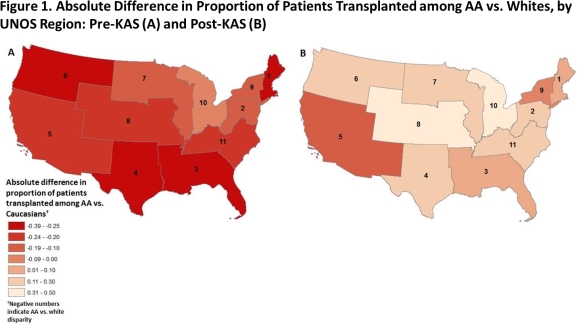Geographic Differences in Racial Disparity Reduction in Kidney Transplant Rates Before and After the New Kidney Allocation System.
1Emory University, Atlanta
2Columbia University, New York.
Meeting: 2016 American Transplant Congress
Abstract number: 513
Keywords: African-American, Allocation, Public policy, Waiting lists
Session Information
Session Name: Concurrent Session: Kidney Waitlist Management and KAS Initial Results
Session Type: Concurrent Session
Date: Tuesday, June 14, 2016
Session Time: 4:30pm-6:00pm
 Presentation Time: 5:06pm-5:18pm
Presentation Time: 5:06pm-5:18pm
Location: Veterans Auditorium
Background: Prior to the new kidney allocation system (KAS) implemented 12/4/2014, significant African American (AA) vs. white racial disparities existed in access to kidney transplantation (KTx) among waitlisted patients. While preliminary results show that the proportion of AA transplanted patients has increased, it is unknown whether this increase has eliminated racial disparities. In addition, it is unknown whether this disparity reduction is consistent across geographic region.
Methods: We examined data from 173,639 patients waitlisted for KTx from the United Network for Organ Sharing (UNOS) standard analytic file from June 2013-June 2015, and divided the cohort into those waitlisted pre- and post-KAS eras. We calculated the proportion of waitlisted patients who received a deceased donor KTx by race as the number of transplants per 100 waitlisted patients; the difference in the proportion of transplants by race (AA vs. white) was mapped by UNOS region using ArcGIS.
Results: Prior to Dec. 4, 2014, a smaller proportion of KTx patients were AAs vs. white (31.5% vs. 42.2%) and all 11 UNOS regions had a racial disparity in KTx; following KAS, the proportion of transplanted patients who were AAs increased to 37.7%. All UNOS regions had a racial disparity reduction in transplant rate from pre- to post-KAS but disparity reduction was not consistent across UNOS region (Figure). Following KAS, regions 5 and 9 still had a racial disparity, where white patients were transplanted at a higher rate than AAs.
Conclusions: Following implementation of KAS, racial disparities were significantly reduced among AA vs. Caucasians, although disparity reduction varied by geographic region. Longer term follow-up is needed to determine whether greater equality in KTx access is sustained.

CITATION INFORMATION: Patzer R, Melanson T, Basu M, Plantinga L, McPherson L, Mohan S, Gander J, Howard D, Pastan S. Geographic Differences in Racial Disparity Reduction in Kidney Transplant Rates Before and After the New Kidney Allocation System. Am J Transplant. 2016;16 (suppl 3).
To cite this abstract in AMA style:
Patzer R, Melanson T, Basu M, Plantinga L, McPherson L, Mohan S, Gander J, Howard D, Pastan S. Geographic Differences in Racial Disparity Reduction in Kidney Transplant Rates Before and After the New Kidney Allocation System. [abstract]. Am J Transplant. 2016; 16 (suppl 3). https://atcmeetingabstracts.com/abstract/geographic-differences-in-racial-disparity-reduction-in-kidney-transplant-rates-before-and-after-the-new-kidney-allocation-system/. Accessed December 18, 2025.« Back to 2016 American Transplant Congress
